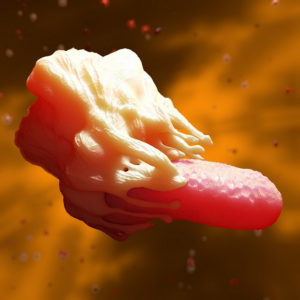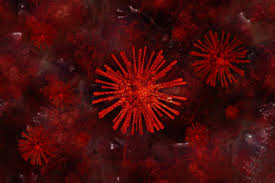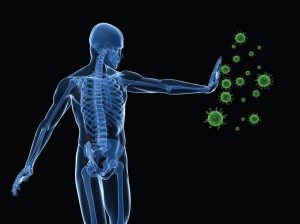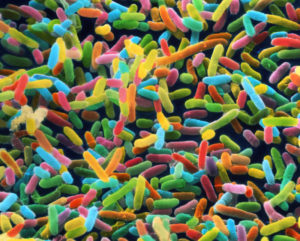Inflammasome activation by retrotransposon RNAs
Short interspersed nuclear elements (SINEs) are noncoding retrotransposons that can be transcribed during cell stress and accumulate in immune-mediated diseases such as atrophic macular degeneration (AMD) and lupus. In mouse and human macrophages, Wang et al. demonstrate that SINE RNAs activate an NLRC4 inflammasome leading to IL-1β/IL-18 secretion, which required cytoplasmic detection by DEAD-box helicase 17 (DDX17). Conversely, SINE RNA–induced inflammasome activation was independent of NLR family apoptosis inhibitory proteins (NAIPs) that are classically required for NLRC4 inflammasome assembly after bacterial infection. In a mouse model of SINE RNA–driven AMD, genetic loss of Nlrc4 or Ddx17 protected mice against retinal degeneration. These results identify NAIP-independent NLRC4 inflammasome activation by retrotransposon RNAs and highlight how endogenous activation of innate immune pathways may contribute to disease pathogenesis (see the related Focus commentary by Barnett et al.).
Abstract
Detection of microbial products by multiprotein complexes known as inflammasomes is pivotal to host defense against pathogens. Nucleotide-binding domain leucine-rich repeat (NLR) CARD domain containing 4 (NLRC4) forms an inflammasome in response to bacterial products; this requires their detection by NLR family apoptosis inhibitory proteins (NAIPs), with which NLRC4 physically associates. However, the mechanisms underlying sterile NLRC4 inflammasome activation, which is implicated in chronic noninfectious diseases, remain unknown. Here, we report that endogenous short interspersed nuclear element (SINE) RNAs, which promote atrophic macular degeneration (AMD) and systemic lupus erythematosus (SLE), induce NLRC4 inflammasome activation independent of NAIPs. We identify DDX17, a DExD/H box RNA helicase, as the sensor of SINE RNAs that licenses assembly of an inflammasome comprising NLRC4, NLR pyrin domain–containing protein 3, and apoptosis-associated speck-like protein–containing CARD and induces caspase-1 activation and cytokine release. Inhibiting DDX17-mediated NLRC4 inflammasome activation decreased interleukin-18 release in peripheral blood mononuclear cells of patients with SLE and prevented retinal degeneration in an animal model of AMD. Our findings uncover a previously unrecognized noncanonical NLRC4 inflammasome activated by endogenous retrotransposons and provide potential therapeutic targets for SINE RNA–driven diseases.
INTRODUCTION
Short interspersed nuclear element (SINE) elements are relatively short [<700 nucleotides (nt)] noncoding retrotransposons that account for more than 10% of the mass of mammalian genomes (1). Evolutionarily, SINEs originate from ancient pseudo-genes of tRNAs, 7SL RNA, or 5S ribosomal RNA (rRNA) and diverged into Alu elements in primates and B elements (B1 and B2) in rodents (2, 3). The genomic expansion of SINE elements requires two steps: RNA polymerase III–mediated transcription and L1-mediated reverse transcription and genomic integration (4). In somatic cells, almost all SINE elements are insertionally inactive; they become transcriptionally active under conditions of cell stress such as virus infection, genome instability, or aging (5–7). Abnormal accumulation of SINE transcripts is increasingly recognized as a culprit in human diseases such as atrophic macular degeneration (AMD) (8), Alzheimer’s disease (9, 10), multiple sclerosis (11), type 2 diabetes (12), and systemic lupus erythematosus (SLE) (13). SINE RNAs induce inflammasome activation and degeneration of the retinal pigmented epithelium (RPE) in an nucleotide-binding domain (NBD) leucine-rich repeat (LRR) pyrin domain–containing protein 3 (NLRP3)–dependent manner but do not require a gamut of cytoplasmic RNA sensors including Toll-like receptors, melanoma differentiation-associated protein 5 (MDA5), and retinoic acid–inducible gene I (RIG-I) (14), thereby leaving the question of the inflammasome-triggering sensor responsible for SINE RNA recognition unanswered.The NLR-containing proteins are a family of heterogeneous proteins that detect the presence of pathogen-associated molecular patterns (PAMPs) or endogenous danger–associated molecular patterns (DAMPs) (15). They typically comprise an N-terminal protein interaction domain, a central NBD, and a C-terminal LRR domain (16). Of these inflammasomes, NLRP3 and NLR CARD (caspase recruitment domain) domain containing 4 (NLRC4) inflammasomes are the best characterized and play important roles in the front line of innate immunity to protect the host from various pathogenic infections (17, 18). Typically, the recognition of microbial stimuli by NLRP3 and NLRC4 is considered indirect; i.e., accessory sensor proteins are thought to be required for ligand recognition and licensing of NLRs activation. For example, assembly of the classical NLRC4 inflammasome requires NLR family apoptosis inhibitory proteins (NAIPs), which sense the bacterial type III secretion apparatus and interact with NLRC4 in an oligomeric state and sequentially recruit apoptosis-associated speck-like protein–containing CARD (ASC) or procaspase-1, leading to its proteolytic cleavage and cytokine maturation (18, 19). Potassium efflux is a common step that is essential for NLRP3 inflammasome activation induced by various stimuli. In response to potassium efflux, the NIMA (never in mitosis, gene A) related kinase 7 acts as an essential partner that interacts with NLRP3 and licenses its activation (20, 21). In addition, cross-talk between NLRP3 and NLRC4 was revealed by studies in Escherichia coli– and Salmonella typhimurium–induced inflammation (22–24) and in sterile inflammation induced by lysophosphatidylcholine (LPC), hyperosmotic stress, or diacylglycerol (DAG) (25–28). During S. typhimurium infection, NLRP3 and NLRC4 can be recruited to same macromolecular complex through ASC (29, 30). Both NLRP3 and NLRC4 inflammasomes have been implicated independently in the pathogenesis of multiple sclerosis (26), a chronic inflammatory disease in which SINE RNA is up-regulated (11); however, the mechanisms regulating the assembly and activation of NLRC4 or NLRP3 inflammasome complexes remain to be elucidated in the context of sterile inflammation. Although the PAMP-induced NLRC4 inflammasome has been extensively studied (31, 32), the mechanism of sterile NLRC4 inflammasome activation, which has been identified in many inflammatory disorders (33, 34), is relatively poorly understood. The roles of NAIPs in the sterile NLRC4 inflammasome are also largely unknown.Here, we report that DEAD-box helicase 17 (DDX17), a DExD/H box RNA family helicase without an established role in inflammasome activation, recognizes cytosolic SINE RNAs and licenses the assembly of an NLRC4 inflammasome complex that includes NLRP3, ASC, and caspase-1. This inflammasome platform facilitates the maturation of caspase-1, secretion of interleukin-1β (IL-1β) and IL-18, and induction of cell death. Targeting this DDX17-mediated NLRC4 inflammasome inhibits RPE degeneration in a model of AMD and IL-18 release by SLE patient–derived cells. These findings identify DDX17, NLRC4, and NLRP3 as potential drug targets in these and potentially other sterile inflammatory disorders.
RESULTS
SINE RNAs induce sterile NLRC4 inflammasome activation
To determine whether NLRC4 participates in SINE RNA–induced inflammasome activation, we transfected primary mouse bone marrow–derived macrophages (BMDMs) isolated from wild-type (WT) or Nlrc4−/− mice with B2 or Alu RNA and monitored caspase-1 processing (p20), lactate dehydrogenase (LDH) release, and IL-1β secretion. SINE RNA transfection in WT BMDMs induced caspase-1 p20 cleavage, LDH release, and IL-1β secretion in a dose-dependent manner, which were greatly impaired in Nlrc4−/− BMDMs (Fig. 1, A and B, and fig. S1, A and B), suggesting that NLRC4 is essential for SINE RNA–induced inflammasome activation. Next, we sought to evaluate the activation of NLRC4 by measuring the phosphorylation of NLRC4 at serine-533 (S533), which contributes to PAMP-induced NLRC4 inflammasome activation (35–37). SINE RNA transfection induced NLRC4 S533 phosphorylation and caspase-1 cleavage in WT mouse BMDMs (Fig. 1C and fig. S1C).







